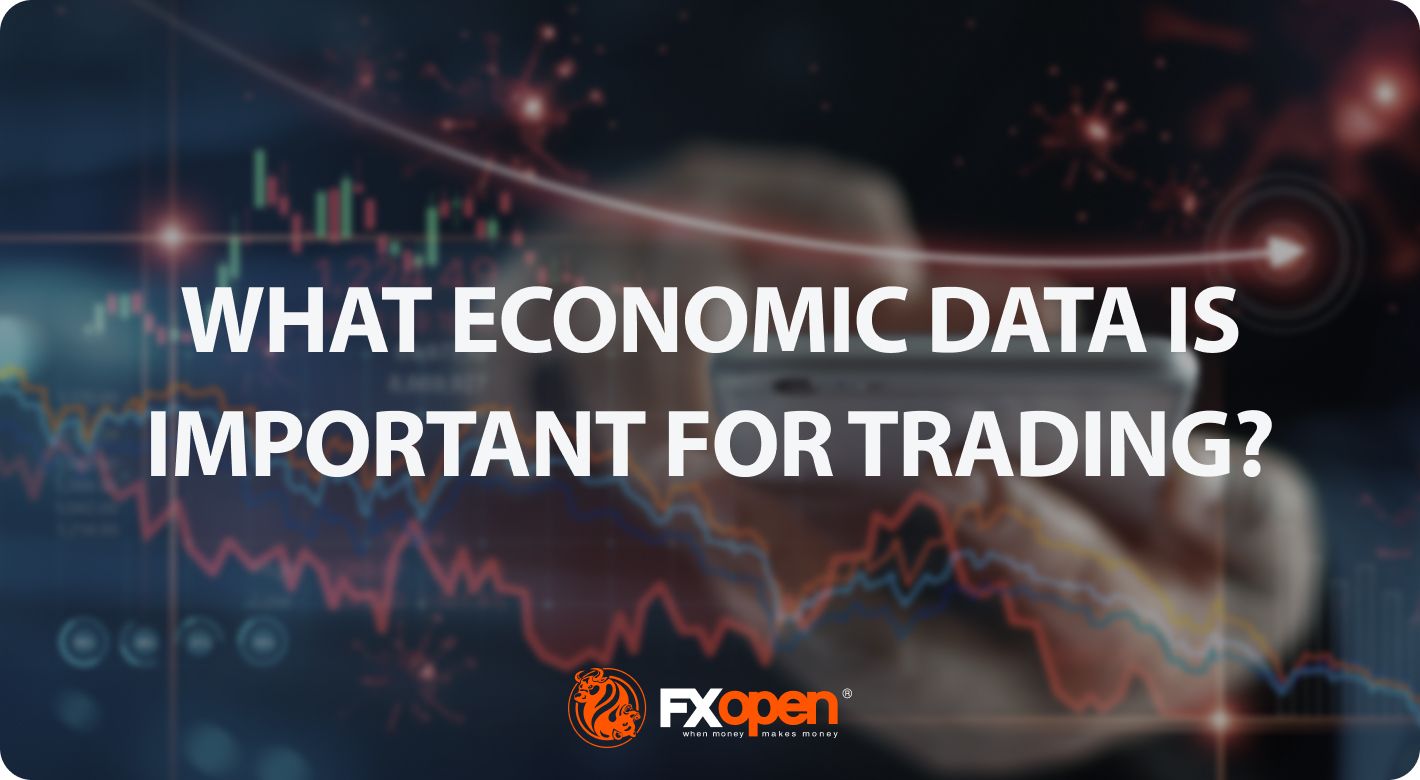FXOpen

Economic data helps traders assess market sentiment, risks, and potential opportunities. It can also be a catalyst for market movements, often causing high price volatility and influencing asset valuations. The release of data, such as employment reports or GDP, can trigger a quick market reaction. If the data is positive, it can boost investor confidence, leading to increased buying activity; if negative, it can trigger sell-offs and risk aversion.
This FXOpen article looks at the role of economic information in trading and defines the key economic indicators that traders rely on. Learn how economic data is intertwined with market movements to determine trading strategies and decisions.
What Is an Economic Indicator?
Economic indicators are statistical data reflecting various aspects of economic performance. For analysts, economists, politicians, and traders, they serve as a yardstick for assessing the current state of the economy. Indicators cover a wide range of data, including employment statistics, inflation rates, and production. Below, you’ll see how they are categorised.
Types of Economic Indicators
Economic indicators fall into three primary categories — leading indicators, lagging indicators, and coincident indicators.
Leading Indicators
Leading indicators provide early signals about the likely direction of future economic activity. They tend to change before the economy begins to follow a particular trend. Examples include stock market indices such as the S&P 500 or Dow Jones Industrial Average, building permits, and the consumer confidence index (CCI). They are valuable for forecasting and planning because they show possible economic trends.
Lagging Indicators
Lagging indicators follow changes in the economy. Examples include the unemployment rate, corporate profits, and the consumer price index (CPI). Lagging indicators provide a retrospective view of the economy. They are valuable for confirming a trend or economic shift that has already occurred.
Coincident Indicators
Coincident indicators move in parallel with the economy, providing real-time information on economic activity. While leading indicators look forwards, and lagging indicators look backwards, coincident indicators reflect the present or very recent past. Examples include industrial production, personal income, GDP, and retail sales.
What Are the Best Economic Indicators for Trading?
Key economic indicators for trading refer to a certain set of essential statistical instruments that are used to assess and analyse the overall state, performance, and trends of the economy. They are considered fundamental to understanding the economic situation in a country or region. Let’s explore some of the indicators that hold paramount importance for traders.
Gross Domestic Product (GDP)
GDP comprises consumer spending, government spending, business expenditures, and net exports. It provides a comprehensive view of the state of the economy. GDP volumes often determine market sentiment, as high growth rates promote optimism and the potential for increased investment.
Labour Market
The state of the labour market is measured by indicators such as the unemployment rate, job creation, initial claims for unemployment benefits, average hourly earnings, and employment change. These indicators have a significant impact on consumer spending, as employment and income levels directly affect consumer confidence.
Inflation Rate
Inflation reduces the purchasing power of the population, so the consumer price index (CPI) and producer price index (PPI) are important indicators for traders. The inflation rate influences the policies of central banks, as they can adjust interest rates depending on the dynamics of inflation.
Interest Rates
Central bank rates are interest rates set by a country’s main bank, such as the Fed in the US or the Bank of England in the UK. Their policies are at the centre of the market’s attention. Interest rates influence borrowing costs, currency markets, and bonds. They often shape traders’ investment decisions.
Manufacturing and Non-Manufacturing PMI
PMI indicators reflect business activity and growth in the manufacturing and non-manufacturing sectors, showing the vitality of the economy. They have an impact on sectoral shares; for example, a high PMI reading leads to increased investment in a sector and vice versa.
Retail Sales
Retail sales reflect the dynamics of consumer spending, which is a key driver of economic growth.
In summary, the most important economic indicators include GDP, the unemployment rate and job creation, the inflation rate (CPI and PPI), central bank rates, PMI indicators, and retail sales. You may choose which indicators to track depending on your needs and preferences. If you are trading currencies, you may pay closer attention to exchange rate-related indicators. If you are active on the stock exchange, economic indicators for the stock market may be beneficial for you.
Trading Strategies Around Data Releases
The release of economic data follows a specific schedule and can be viewed through economic calendars provided by financial news publications and trading platforms. Traders often use a variety of strategies to capitalise on data releases, including trading before, during, or after the data is out, depending on their risk tolerance and trading style. Let’s examine the main points:
Market expectations can outweigh actual data. Market reactions can be influenced not only by the data itself but also by how it relates to market expectations. Deviations from consensus forecasts can lead to increased volatility.
There are revisions to economic data. Economic indicators are subject to revisions, which can affect market sentiment. Traders seek to be aware of data revisions to adjust their portfolios accordingly.
Global economic data influences the whole world. Global economic changes, especially data on leading countries, can influence various markets, even those we might not expect. Traders monitor global news for possible market impact.
Risks and Challenges
Trading based on economic data comes with its share of risks and challenges, including market volatility, interpretation errors, and the influence of geopolitical factors.
- Data releases often lead to short-term market volatility, which can pose risks to traders, especially those with leveraged positions.
- Misinterpreting economic indicators can lead to incorrect trading decisions. It’s crucial to have a solid understanding of the data and its implications.
- Geopolitical events, such as trade tensions or political instability, can override the impact of economic data on markets.
It’s advisable to do your own research and evaluate all the factors carefully. Traders may use the TickTrader platform to conduct technical analysis and read the FXOpen blog to keep up with the market news.
Final Thoughts
Economic data serves as an indispensable compass, guiding traders through the financial markets. By constantly monitoring economic data updates, traders can navigate the complexities of global markets more accurately and confidently. You can open an FXOpen account to dive into trading and apply the findings from the latest data yourself.
This article represents the opinion of the Companies operating under the FXOpen brand only. It is not to be construed as an offer, solicitation, or recommendation with respect to products and services provided by the Companies operating under the FXOpen brand, nor is it to be considered financial advice.
Stay ahead of the market!
Subscribe now to our mailing list and receive the latest market news and insights delivered directly to your inbox.








